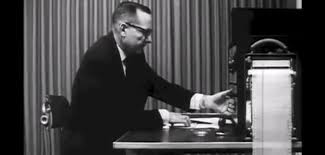If you were ordered to deliver a 400-voltage-shock to another human being by an authority figure, would you do it? Most people would answer “No,” sure of the fact that they would never inflict pain on another person. However, the Milgram Experiment proved otherwise. Why is it that so many individuals obey orders when they are told to, even when they know the orders are wrong? Social psychologist Stanley Milgram researched the power of authority and obedience. Milgram’s experiment on obedience analyzes the psychological processes underlying compliance with orders to commit despicable acts.1
Experiments began in July 1961, three months after the trial of World War II criminal, Adolf Eichmann. He was responsible for ordering the deaths of millions of Jews, but he said he was “just following orders.” He claimed that he did it simply because he was told to. This made Milgram question the power of authority. He questioned, “Could it be that Eichmann and his million accomplices in the Holocaust were just following orders? Could we call them all accomplices?” Throughout history soldiers have followed orders to murder innocent people. So many examples include the Nazi’s killing the Jews, the Turkish slaughter of the Armenians, and the Serbian killings of both Bosnian and Kosovar Muslims. We understand that these were terrible acts and wonder how anyone is capable of committing them. But how many of us would refuse to follow these orders if they came from an authority figure, someone in control, and who obtained power over you?2

The purpose of the experiment was to test whether ordinary people were capable of inflicting harm on others if an authority figure pressured them to do so. Using a newspaper ad, forty men were recruited for the experiment, and each person was paid $4.50. Participants were led to believe that they were assisting in an unrelated experiment, in which they had to administer electric shocks to a “learner.” And they were told that the fake electric shocks were to be gradually increased to fatal levels, if they had been real. Three individuals took part in each session: the “experimenter” (in charge to the session), the “teacher” (the volunteer who was misled to believe that they were merely assisting), and the “learner” (an actor and a confederate of the experimenter who pretended to be a volunteer).3

The actor and participant arrived to the session together, and they both drew slips of paper to determine their roles. Each slip of paper said “Teacher,” but the actor claims to have “Learner,” to guarantee that the subject will always be the “Teacher.” Milgram created a shock generator with different shock levels, starting at 30 volts and going all the way up to 450 volts. Each volt level had a label, such as “slight shock,” “moderate shock,” and “Danger: Extreme Shock.” Whenever an incorrect answer was given from the “Learner,” he was given a shock.4 The participant believed that he was delivering real shocks, but the “student” was a confederate in the experiment, and was just pretending to be shocked. As the experiment progressed, the experimenter would hear the student plead to be released or complain of a heart problem. Once it reached 300-volts, the student would demand to stop. The student would refuse to answer anymore questions, the experimenter instructed the participant to treat the silence like an incorrect answer and shock them.5

Most participants would start to feel they needed to stop before the voltages became too high. They would ask if they should continue and the experimenters would tell them specific verbal encouragements. These were given in this order: “Please continue,” and “The experiment requires that you continue,” and “It is absolutely essential that you continue,” or “You have no other choice, you must go on.” If the subject still wanted to stop after all of these verbal encouragements, the experimenter ended the experiment. If they did not choose to stop, it ended after the subject had given the maximum shock three times during the session. Out of the forty participants, twenty-six delivered the maximum shock while fourteen stopped before reaching the higher levels.6

The experimenter used specific prods for any questions the subject may have had. If the subject was worried about the learner wanting to stop, the experimenter replied, “Whether the learner likes it or not, you must go on until he has learned all the word pairs correctly, so please go on.” While most of the participants were agitated at the experimenter, they still followed the orders that were given.7 The participants experienced anxiety from the experiment, and they learned the truth at the end. The researchers explained they used deception. Milgram raised moral questions, such as why did so many of the participants in this experiment perform a seemingly sadistic act when instructed by an authority figure? Milgram came to the conclusion that, “Ordinary people, simply doing their jobs, and without any particular hostility on their part, can become agents in a terrible destructive process. Moreover, even when the destructive effects of their work become patently clear, and they are asked to carry out actions incompatible with fundamental standards of morality, relatively few people have the resources needed to resist authority.” Milgram’s experiment has inspired psychologists around the world to research more about what makes people comply with orders and what makes them question authority.8
- Thomas Blass, The Man Who Shocked the World: The Life and Legacy of Stanley Milgram (Basic Books, 2004), 1-8. ↵
- Stanley Milgram, “Behavioral Study of Obedience,” Journal of Abnormal and Social Psychology, no.1 (1963): 1, accessed May 8, 2019, http://citeseerx.ist.psu.edu/viewdoc/download?doi=10.1.1.424.795&rep=rep1&type=pdf. ↵
- Stanley Milgram, “Behavioral Study of Obedience,” Journal of Abnormal and Social Psychology, no.1 (1963): 1, accessed May 8, 2019, http://citeseerx.ist.psu.edu/viewdoc/download?doi=10.1.1.424.795&rep=rep1&type=pdf. ↵
- R. Brown, “Social Forces in Obedience and Rebellion,” Social Psychology 2, no. 1 (1986): 5. ↵
- Stanley Milgram, “Some Conditions of Obedience and Disobedience to Authority,” Human Relations, no.1 (1965): 57. ↵
- Eugen Tarnow, “Towards the Zero Accident Goal: Assisting the First Officer Moniter and Challenge Captain Errors,” Journal of Aviation/Aerospace Education and Research 10, no. 1 (2000): 30. ↵
- Vladimir Tumanov, “Stanley Milgram and Siegfried Lenz: An Analysis of Deutschstunde in the Framework of Social Psychology,” Neophilologus: International Journal of Modern and Mediaeval Language and Literature, no.1 (2007): 146. ↵
- Stanley Milgram, “Obedience to Authority: An Experimental View,” New York: Harper and Row, no.1 (1974): 15. ↵



33 comments
Alin Bocardo Felix
A very common question that comes to mind, is how is it that so many people did what they did during WW2. In a way, this answers that question, but it is still very open ended. The human brain works in ways that sometimes science will not be able to explain, and the reason behind the way people act is still unknown. The experiment put into perspective a small portion of the way people reacted to such commands, the participants may have had self-ethical issues after finding out it was an observation of them and their character. Overall, the article is well written, detail oriented and organized; the title is intriguing and does encompass the the rest of the information presented.
Ariana Brown
This was interesting because I expected it to go more into the realm that the Stanford Prison Experiment did. By saying this, I mean in the aspect that people took on their role too well but instead it more so explored the aspect of “power” and being told what to do. This is definitely something that I have seen in my own work life. I would be interested in seeing this experiment done again with different people due to the variable of fake electroshock and people’s acting abilities.
Sebastian Azcui
I read about this experiment before but never understood it since I did not know the details. The human mind is something very difficult to understand and it is impressive how people can follow orders from someone with more “power” no matter what it is. It is shicking how people can easily be manipulated and driven to different things. I find it very hard of how someone with power can drive another human to cause harm to another human. Due to the human mind, people follow orders even if they know that it is wrong.
Cristianna Tovar
The question of what people will do while under the supervision of an authoritative figure has always fascinated me. Although I can see why people went through with “administering” the shocks to the learner since they were told things like “It is absolutely essential that you continue,” and “whether the learner likes it or not, you must go on until he has learned all the word pairs correctly, so please go on,” it’s still hard for me to imagine that most people would administer the shock if they knew that it could kill the other person. It seems as though that once a person is told what to do by an authoritative figure, their moral compass disappears and the only thing they worry about is pleasing the person in charge by doing what they say. It’s a sad reality, but it is also important to learn about why we do the things that we do.
Azucena Cuevas
I have briefly heard about this experiment, and it still shocks me that an authority figure can really convince a person to do harm. It seems like common sense to say no when one knows its morally wrong, but more than half of the people in this experiment kept going even if they disagreed. The author really clarified every detail of the experiment and it was a good read. Also, it is of benefit for psychologist to continue to research such a fascinating subject.
Cynthia Perez
This article really enveloped the idea of an individual’s morals conflicting with violent acts being made when ordered by an authority figure. Seeing how some people would willingly cause a lot of harm to another human being only because they were told to is concerning but then again people have been ordered to complete a task, regardless of how intense it can be, for years. All the wars from the past could have influenced this behavior and even all of the influential leaders that were considered powerful in their ability to inspire a widespread audience. It’s astonishing how much control just one person in the position of power can have over another person.
Nicole Ortiz
I have never heard of this experiment until now and its shocking to see how manipulative people can be of others. If someone with malicious intentions ever tried to actually do this, there would be many people that would actually get hurt and possibly killed due to the human instinct of obeying orders from those with a higher authority than us. I think we tend to have that instinct because we don’t want to make that higher authority upset towards us and risk us injuring ourselves so we would rather just listen to them and injure others because it’ll detour the pain from occurring to us. As sad as it may seem, that’s just how humans are and in knowing this, people from the past like Hitler and the Nazi’s did these kinds of things.
Sierra Salas
Before reading this article, I had no idea this experiment existed. I was surprised at the fact that a majority of the participants, although some being agitated with the experiment, continued to shock the fake test subjects. I had no idea that good people could engage in such horrific acts, due to the fact that they were told to. In some cases, this makes me question whether some people who commit acts of injustice because they are told too are actually good intentioned people who don’t have the will power to say no to authority. Or maybe they fail to question the person of authority and their intentions.
Skylar De Leon
This article really showed me the acts of malice that one is capable of due solely to the commands of a figure of authority. I had heard of this experiment before at some point, but I had somewhat forgotten the number of how many people actually went through with giving the final and more extreme shock. It’s quite disturbing to say the least, to know that if someone is merely told to deliver heinous acts by someone of power, it’s more than likely that they will comply.
Todd Brauckmiller
The moment I read the title I already knew what I was getting myself into. In my senior year of high school our sociology teacher had shown us a documentary of this experiment. To me I found this test very useful, Milgram had good attentions behind his experiment. Despite being horrible acts of harm most individuals still continued to give shocks. This might mean that some of the Nazi army weren’t really doing it because they wanted to but to do it because they were told to.